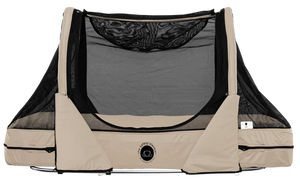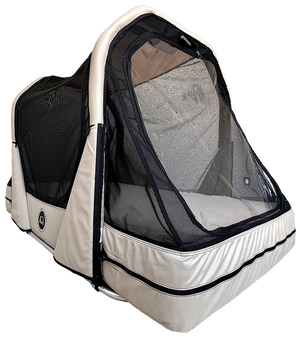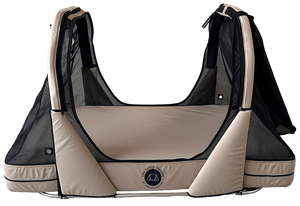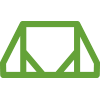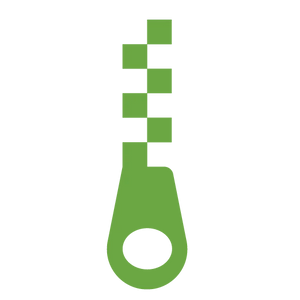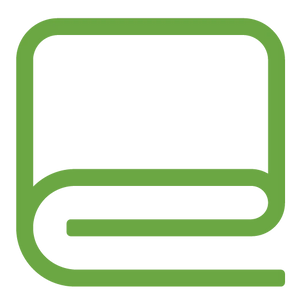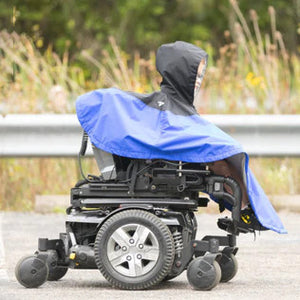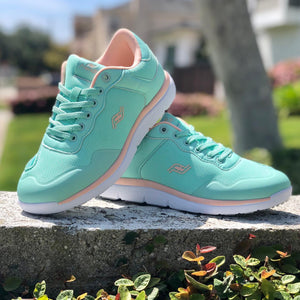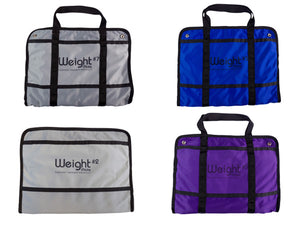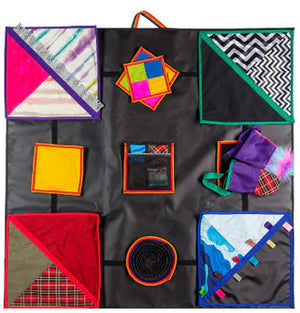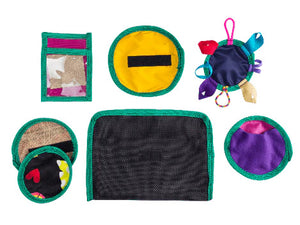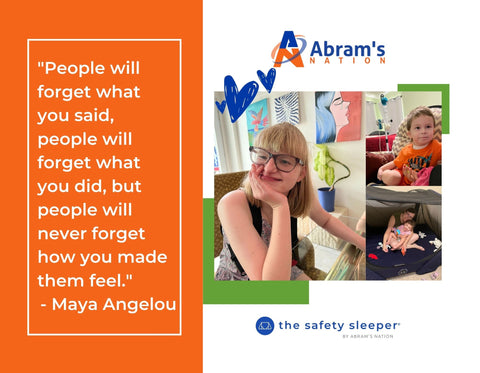WHO NEEDS A SAFETY BED?
COMMON DIAGNOSES BEHIND The Safety Sleeper®
The Safety Sleeper® is uniquely designed to combat sleep disturbances, night wandering, and violent outburst associated with multiple special needs diagnosis. Whether your child is hypersensitive or sensory seeking, they are sure to love the fully enclosed design of The Safety Sleeper®.
Trust your loved one with special needs is safe, contained, and comfortable through the night. Let the whole family rest, and finally take a sign of relief knowing that your child won’t be able to wander around the house without supervision. Learn more about the people and diagnoses behind The Safety Sleeper® here.

What diagnoses are common with The Safety Sleeper® audience?
- Frequency:
Rare Neurodevelopmental genetic disorder affecting less than 300 world wide. - What is it?
ADNP syndrome is a condition that causes a wide variety of signs and symptoms. Its hallmark features are intellectual disability and autism spectrum disorder, which is characterized by impaired communication and social interaction. Affected individuals also have distinctive facial features and abnormalities of multiple body systems. - Patient Challenges:
Mild to severe intellectual disability
Delayed development of speech and motor skills such as sitting and walking
Some affected individuals are never able to speak
Exhibit features typical of autism spectrum disorder
Repetitive behaviors
Difficulty with social interactions
Mood disorders or behavioral problems, such as anxiety, temper tantrums, attention-deficit/hyperactivity disorder (ADHD), obsessive-compulsive disorder, or sleep problems - Parent Challenges
Sleep problems
Parent challenges related to the Autism Spectrum Disorder
Weak muscle tone in child requiring extra care
Digestive problems, constipation, vomiting, obesity, seizures, and heart abnormalities.
- Frequency:
Neurogenetic Disorder affecting 1 in 10,000 - 25,000 individuals interactions, obsessive interests, and repetitive behaviors. - What is it?
Complex genetic disorder primarily affecting the nervous system caused by the deletion of a chromosome or genetic mutation. Often accompanied by a happy, excitable demeanor and hyperactivity. Common symptoms include delayed development, intellectual disability, motor and balance issues, speech impairment, and in severe cases seizures. - Patient Challenges:
Difficulty sleeping
Hyperactivity
In severe cases, recurrent seizures
Excessive chewing and mouthing behavior
Frequent laughter and a happy, excitable nature
Curvature of the spine - Parent Challenges
Provide consistency
Create a safe environment conducive to convulsive movements
Reward good behavior
Manage seizures with medication and a safe environment at all times
Develop proper communication techniques
Provide physical and behavioral therapy - Resources
- Frequency:
A serious developmental disorder that impairs the ability to communicate and interact. The range and severity of symptoms can vary widely. Common symptoms include difficulty with communication, difficulty with social interactions, obsessive interests, and repetitive behaviors. - What is it?
A serious developmental disorder that impairs the ability to communicate and interact. The range and severity of symptoms can vary widely. Common symptoms include difficulty with communication, difficulty with social interactions, obsessive interests, and repetitive behaviors. - Patient Challenges:
Night Wandering
Compulsive behavior
Impulsivity (playing vs sleeping)
Self-harm (e.g. banging head on wall)
Obsessive Interests - Parent Challenges
Provide consistency
Create a home safety zone
Visual cues often helpful
Reward good behavior
Understand hypersensitivities to light, sound, touch, taste, and smell
Understand child’s triggers (i.e. what is stressful, frightening, calming, uncomfortable, enjoyable)
Stick to a schedule
Resources
Accommodation Resources: ASD & AspergersSigns of Autism in GirlsNational Autism AssociationAutism Society of AmericaAutism Help Network Inc.National Autism ResourcesAutism Resources for FamiliesSesame Street and AutismCDC Autism ResourcesOperation AutismSleep problems in autism, explainedAutism and addictionACEing AutismEmpowering Children with ASD for Better Sleep- Frequency:
Neurological Disorder affecting 1 in 1,500 - 4,000 individuals - What is it?
Group of disorders that affect a person's ability to move and to maintain balance and posture. The most common form is spastic cerebral palsy where there is damage in the motor cortex causing stiff and tight muscles. - Patient Challenges:
Prone to epilepsy
Difficulty sleeping because of muscle spasms
Uncontrolled or unpredictable movements
Difficulty walking
Difficulty balancing, moving, communicating, eating, and learning
Hearing and/or vision impairment - Parent Challenges
Provide proper equipment to assist in movement and provide safety
Help child exercise at home
Serve healthy foods that can help strengthen bones and muscles
Assist child in daily activities
- Resources
The CHARGE Syndrome Second Edition includes comprehensive information on the physical, sensory, communicative and behavioral findings in CHARGE. Authors are all recognized experts in CHARGE, including many from the CHARGE Center at Cincinnati Children's Hospital Medical Center.
- Resources
- Frequency:
Genetic Disorder affecting 1 in 700 individuals - What is it?
A genetic disorder caused by an extra chromosome in each cell. Often characterized by distinct physical traits including low muscle tone, small stature, an upward slant to the eyes, and a single deep crease across the center of the palm. Neurological development is often delayed. - Patient Challenges:
Higher risk for epilepsy
Emotional problems including ADHD, anxiety, and/or depression
Disrupted sleep from sleep apnea
Hearing loss that often is dealt with by learning sign language
Thyroid problems that can affect temperature and energy
At risk for congenital heart disease
Higher risk for infections
Vision impairments including cataracts
Low strength attributed to poor muscle tone - Parent Challenges
Create a safe environment conducive to convulsive movements
Provide consistency
Use pictures to make a daily schedule your child can see
Create a daily routine
Provide proper medication and assistance in activity changes
- Frequency:
Neurological Disorder affecting 1 in 2000 - 3000 individuals - What is it?
Neurological disorder where an excessive surge of electrical activity in the brain can cause a variety of symptoms. Two main types are focal seizures occurring in one small region of the brain and generalized seizures involving both hemispheres of the brain. - Patient Challenges:
Jerking movements
Blinking
Loss of muscle tone
Stiffening of limbs - Parent Challenges
Create a safe environment conducive to convulsive movements
Carefully manage and regulate medications
Provide proper therapies
- Resources
- Frequency:
We’re not sure and we don’t have a reliable estimate. There are people who have not been diagnosed using the most sophisticated chromosomal testing or have not joined our organization and so we can’t count them. It is estimated that 1% of people with autism have Phelan-McDermid syndrome. That means that between 1/8,000-15,000 (including 22q13.3 deletions and SHANK3 gene variants) have PMS. However, this may be an underestimate since not all patients with PMS will present with autism. - What is it?
Phelan-McDermid syndrome (PMS), is also known as 22q13 Deletion syndrome. It is a genetic condition that is caused by a variance of the SHANK3 gene or a deletion (a missing piece) of genetic material that causes many different but related symptoms. The genetic changes that cause PMS vary from person to person and can occur randomly (de novo) or be inherited from a parent who carries a related genetic change. Because the genetic changes vary, the symptoms of PMS also vary and can cause a wide range of medical, intellectual, and behavioral challenges. - Patient Challenges:
Intellectual disability of varying degrees
Delayed or absent speech
Symptoms of autism spectrum disorder
Low muscle tone
Motor delays
Epilepsy - Parent Challenges
Create a safe environment conducive to convulsive movements
Carefully manage and regulate medications
Provide proper therapies
- Frequency:
Approximately 500 cases have been identified worldwide - neurogenetic disorder - What is it?
Condition characterized by intellectual disability and developmental delay, breathing problems, epilepsy, and distinctive facial features. They often have difficulty talking and exhibit many features of autistic spectrum disorders. It’s caused by genetic mutation essential to the development of the brain. - Patient Challenges:
Epilepsy common
Little speech
Hyperventilation and sleep apnea
Delayed development of mental and motor skills - Parent Challenges
Create a safe environment conducive to seizures
Reward good behavior
Provide consistency
Medication to prevent seizures, ease breathing and constipation
Diet to better manage constipation and GI issues
Physical, occupational and behavioral therapy
- Frequency:
Genetic disorder affecting 1 in 25,000 individuals - What is it?
A rare genetic disorder caused by a chromosome duplication in each cell. Common symptoms include weak muscle tone, swallowing difficulties, and delayed development. Many patients are born with heart defects and are more prone to diseases like sickle cell anemia and cancer. - Patient Challenges:
Hyperactivity or impulsive behaviors
Sleep problems including sleep apnea, problems falling asleep, and staying asleep
Difficulty with speech
Difficulty with social interactions and communication - Parent Challenges
Create a safe environment conducive to convulsive movements
Provide consistency
Provide proper communication and behavioral therapy
Regulation of diet and health
Provide proper medication and assistance in daily activities
- Frequency:
Genetic disorder affecting 1 in 8,000 - 20,000 individuals - What is it?
Rare genetic disorder caused by deletion of a vital chromosome. It causes poor muscle tone, low levels of sex hormones, and a constant feeling of hunger. In most cases, the patient is at risk for severe obesity. - Patient Challenges:
Sleep disturbances
High pain threshold
Behavioral challenges that may include anxiety, OCD, skin picking, and uncontrollable emotions
Obesity
Short stature
Poor motor skills
Underdeveloped sex organs
Mild intellectual and learning disabilities - Parent Challenges
Provide consistent and safe environments
Regulate schedules
Reward good behavior
Implement positive behavior strategies
Provide proper medications addressing issues
Manage weight and eating
- Frequency:
Neurodevelopmental Disorder affecting 1 in 10,000 - 23,000 individuals, mostly female - What is it?
Rare genetic disease that causes developmental and nervous system problems. There are varying severities of symptoms, but common ones include loss of communication skills and reduced control of hand movements. Motor problems often increase with age while interaction and communication often improve. - Patient Challenges:
Compulsive movements
Balance problems
Seizures
Loss of speech and hand movements
Breathing problems
Intellectual disability - Parent Challenges
Create a safe environment conducive to compulsive movements
Reward good behavior
Help child walk
Reposition them for comfort
Control drooling problems
Manage medications
- Frequency:
Neurobehavioral Disorder affecting 1 in 25,000 individuals - What is it?
A developmental disorder caused by a deletion of genetic material on part of a chromosome that affects intellectual ability, speech and language, and behavior. Common symptoms include mild to moderate intellectual disability, delayed speech and motor skills, distinctive facial features, sleep disturbances, and behavioral problems. - Patient Challenges:
Chronic sleep disturbances
Frequent temper tantrums and outbursts
Self-injury
Excessive daytime sleepiness / sleep debt
Negative reactions to change in activities
Difficulty paying attention
Repetitive behaviors like arm hugging, hand squeezing, body rocking, etc. - Parent Challenges
Create a familiar safe environment
Provide sensory activities to regular child’s responses to sensory stimuli
Reward good behavior (fidget folder - communication pack)
Work on facilitating appropriate and supportive social interactions
Provide a total communication program that often involves sign language - Resources
HELPFUL PRODUCTS, ACCESSIBLE SPACES, & SERVICES
ACEing Autism is on a mission for children with autism to grow, develop and benefit from social connections and fitness through affordable tennis programming, uniquely serving individual needs while filling a national void for this growing and worthy population. ACEing Autism is a 501(c) 3 nonprofit organization.
Visit WebsiteProviding assistance for children with autism of military families.
Visit WebsiteOfficial charity of the United States Air Force sponsoring programs that improve quality of life for Airmen and their families.
Visit WebsiteVacations for adults and families living with Autism, Down Syndrome, and other related disabilities.
Link to WebsiteNon–profit organization that grants wishes to children/teens ages 0-18 who are struggling due to emotional, physical or financial issues.
Visit WebsiteThe Children’s Home of Pittsburgh, established in 1893, is an independent, non-profit licensed organization whose purpose is to promote the health and well-being of infants and children through services which establish and strengthen the family.
Visit WebsiteFor families in the greater Western Pennsylvania region, lots of summer camp programs are opening again for the 2021 season. In this PDF, browse summer camp openings ranging from Camp SPEAK, Camp ROCK, Class ESY, and UPMC/Merck Summer Treatment Programs, there truly is something for everyone!
Open PDFCreated by parents of a tube-fed child, the FreeArm Tube Feeding Assistant holds gravity and pump feeds. The FreeArm lends a hand at the hospital, home, and on-the-go by clamping to surfaces such as tables, cribs, strollers, and more! With the FreeArm's bendable arm, you can take the guesswork out of how high to hold the gravity syringe and keep lines free from kinks.
Visit WebsiteFind destinations using specific accessibility categories and features.
Visit WebsiteGive Kids The World Village is an 89-acre, whimsical nonprofit resort in Kissimmee, Florida, that provides week-long, cost-free wish vacations to critically ill children and their families from around the world who want to visit Central Florida.
Visit WebsiteCustom covers for central lines, ostomy pouches, feeding tubes and more.
Visit WebsiteJake’s Help From Heaven, founded in 2011, is a non-profit foundation dedicated to supporting individuals with multiple medical challenges and disabilities. Countless challenges occur in caring for medically fragile, special needs individuals. Our goal is to assist individuals affected by debilitating illnesses.
Visit WebsiteNon–profit organization that seeks to empower and assist children with disabilities by donating home building material and equipment.
Visit WebsiteGranting wishes of children with life-threatening medical conditions.
Visit WebsiteThe world's first Ultra-Accessible™, family fun park located in San Antonio, Texas.
Visit WebsiteWe deliver happiness to seriously ill children and their families at more than 800 children’s hospitals and health care facilities in the US. Our state-of-the-art programs like Starlight Virtual Reality, Starlight Hospital Wear, and Starlight Gaming entertain, distract, and inspire hospitalized kids. Since 1982, Starlight has brought smiles to more than 17 million seriously ill children and their families.
Visit WebsiteThe Suite Dreams Project is a unique and innovative program of the General Sports Foundation, a Michigan non-profit organization. Our focus is to serve children and families in low and moderate income, urban and rural areas by transforming their bedrooms into beautiful healing spaces where they can rest and recover. The Suite Dreams Project utilizes the assistance of designers and volunteers to create these unique environments complete with healing elements specific to the needs of each sick child. We assist in obtaining any furniture, materials and equipment necessary to create the “suite” of each child’s dream.
Visit WebsiteSunshine Foundation’s sole purpose is to answer the dreams of chronically ill, seriously ill, physically challenged and abused children ages three to eighteen, whose families cannot fulfill their requests due to financial strain that the child’s illness may cause.
Visit WebsiteIf you choose to buy or crowdfund from us using MobilityFunder®️, I want you, your child, or someone you care about to feel the way I do when using the right equipment that makes a difference. -Andy Huesing, Founder / Director
Visit Website501c3 non-profit aligning resources to assist with medical equipment and provide support for promising therapies with the potential to produce significant recovery gains from the life altering effects of spinal cord injury (SCI).
Visit Website501c3 non-profit aligning resources to assist with medical equipment and provide support for promising therapies with the potential to produce significant recovery gains from the life altering effects of spinal cord injury (SCI).
Visit WebsiteReagan’s Journey Inc. exists to MAKE LIFE BETTER for children with special needs through events, lending clothset, and raising awareness and improving our communities.
Visit WebsiteWHY CHOOSE THE SAFETY SLEEPER®?
- Protect against night wandering caused by irregular sleep cycles
- Shield your loved one from self-harming behaviors (e.g. banging head on wall)
- Provide a padded and safe enclosure for cool-downs during violent outbursts and tantrums
- Protect against the problems associated with recurrent seizures, like falling out of bed, hitting head, and violent activity
FULLY-ENCLOSED BEDS FOR SPECIAL NEEDS
Fully enclosed protection for your loved one


One side entry for independent individuals who need extra protection and don't use medical tubing or wires.
CUSTOMIZE

One left side entry, end of bed entry, and access points for medical tubing. Designed for individuals with medical equipment.


Both side door entries, option for complete center opening, and access points for medical tubing. Compatible with lifts and canopies.
CUSTOMIZEHAVE QUESTIONS?
CONTACT US
TESTIMONIALS
MEET OUR FAMILIES
The Safety Sleeper® has provided peace of mind to special needs families for over a decade. Meet the faces behind our bed, here.
 View testimonials
View testimonials
